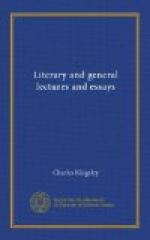Michael Angelo rarely gave wings to his angels; I scarcely recollect an instance, except the angel in the “Annunciation:” and his exaggerated human forms, his colossal creatures, in which the idea of power is conveyed through attitude and muscular action, are, to my taste, worse than unpleasing. My admiration for this wonderful man is so profound that I can afford to say this. His angels are superhuman, but hardly angelic: and while in Raphael’s angels we do not feel the want of wings, we feel while looking at those of Michael Angelo that not even the “sail-broad vans” with which Satan laboured, through the surging abyss of chaos could suffice to lift those Titanic forms from earth, and sustain them in mid-air. The group of angels over the “Last Judgment,” flinging their mighty limbs about, and those that surround the descending figure of Christ in the “Conversion of St. Paul,” may be referred to here as characteristic examples. The angels, blowing their trumpets, puff and strain like so many troopers. Surely this is not angelic: there may be power— great, imaginative, and artistic power—exhibited in the conception of form, but in the beings themselves there is more of effort than of power: serenity, tranquillity, beatitude, ethereal purity, spiritual grace, are out of the question.
In this passage we may remark an excellence in Mrs. Jameson’s mode of thought which has become lately somewhat rare. We mean a freedom from that bigoted and fantastic habit of mind which leads nowadays the worshippers of high art to exalt the early schools to the disadvantage of all others, and to talk as if Christian painting had expired with Perugino. We were much struck with our authoress’s power of finding spiritual truth and beauty in Titian’s




